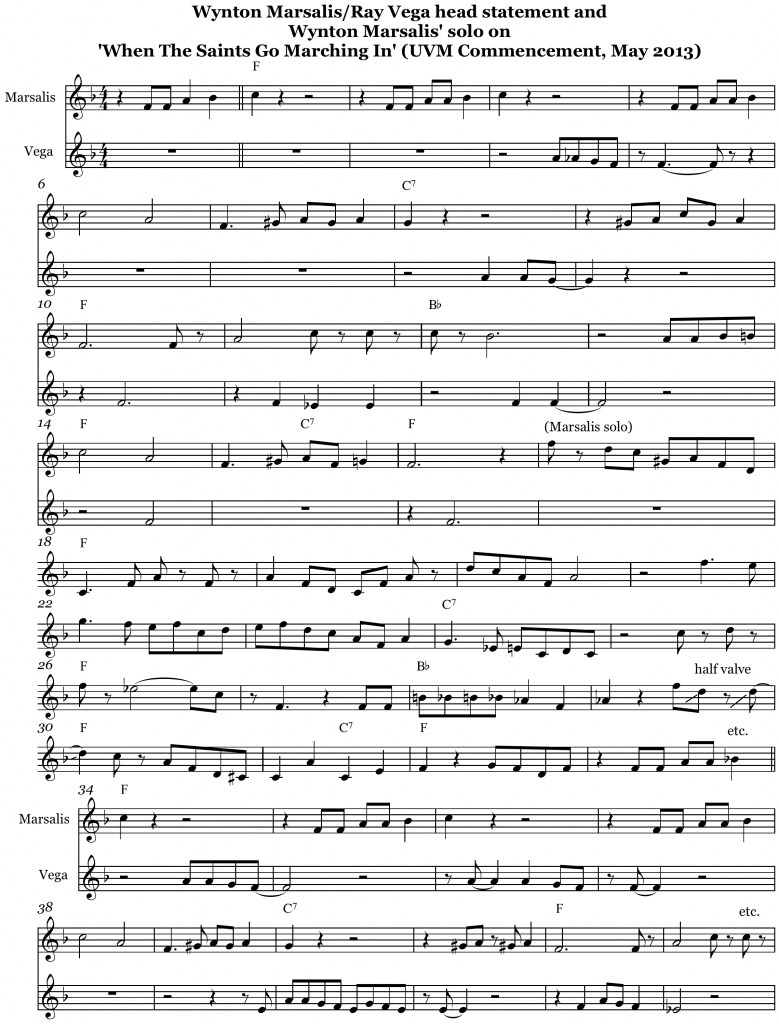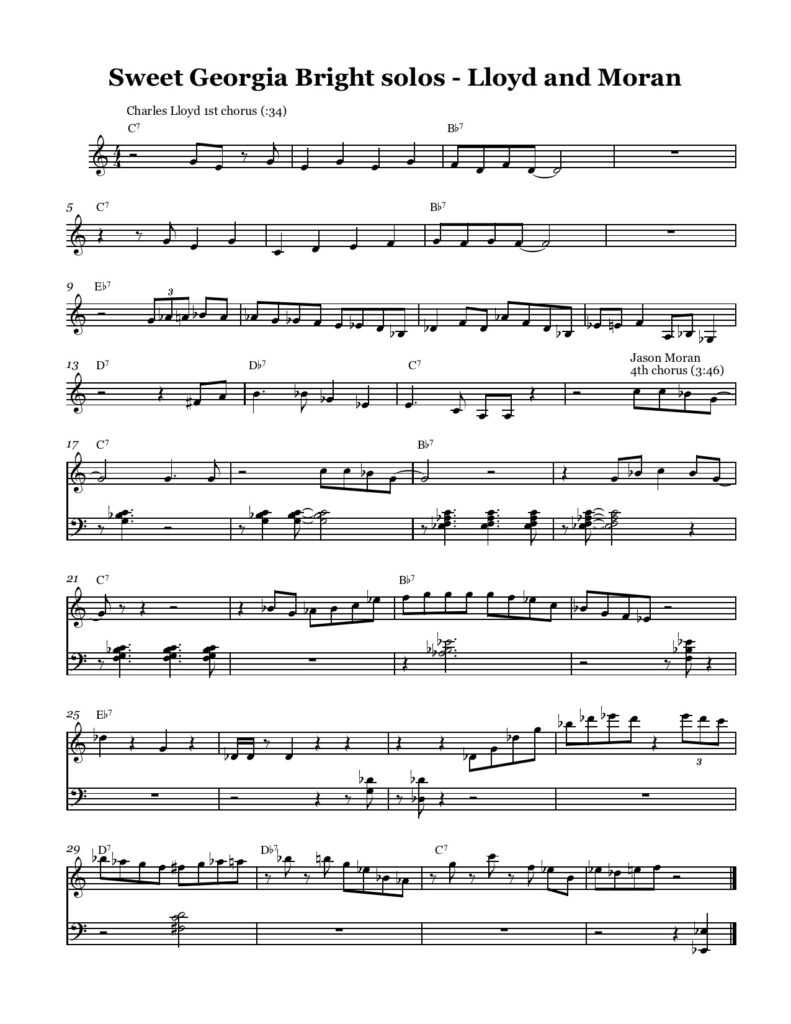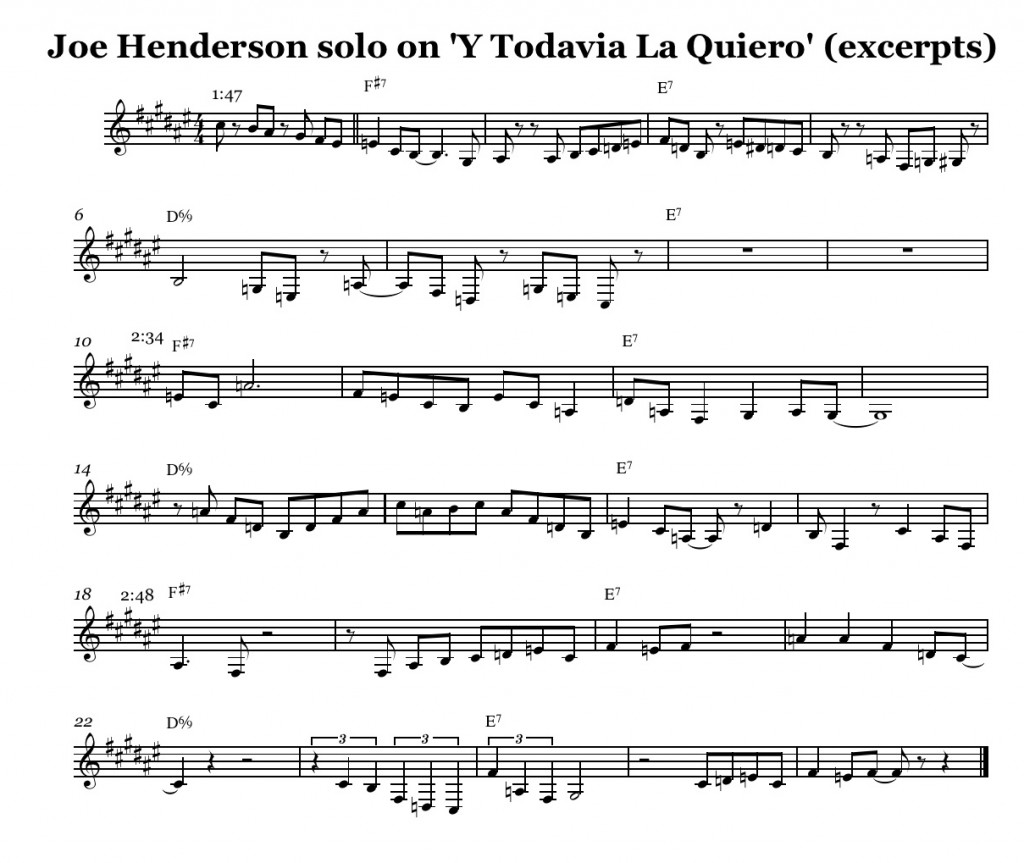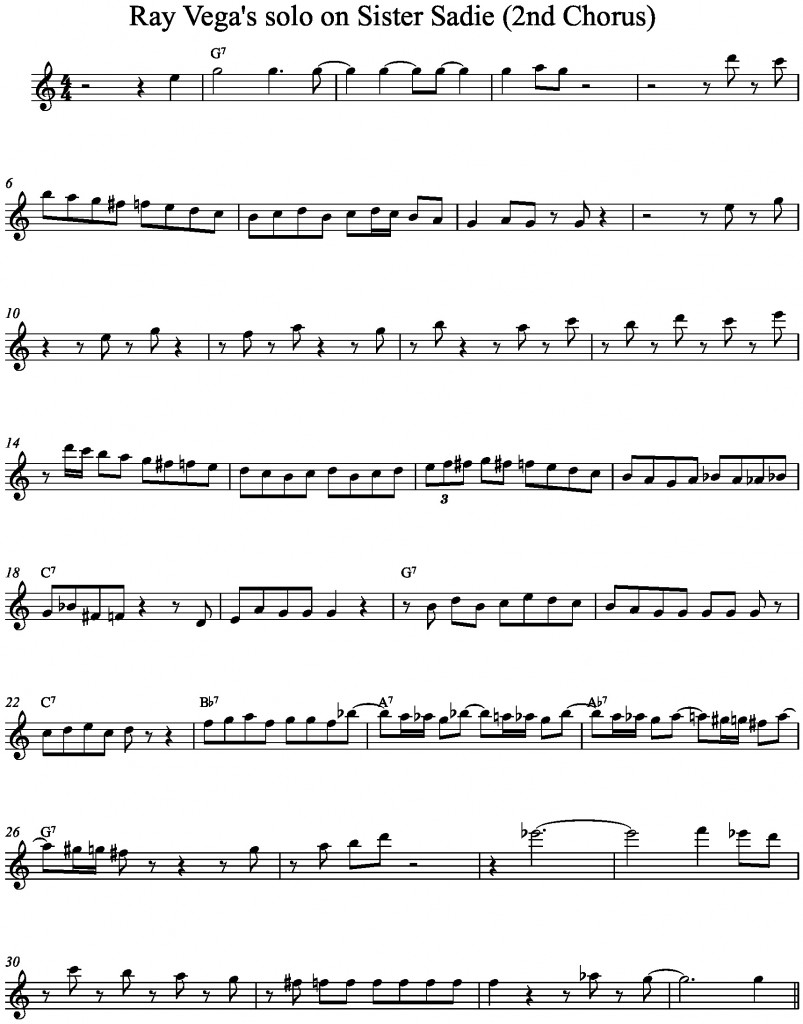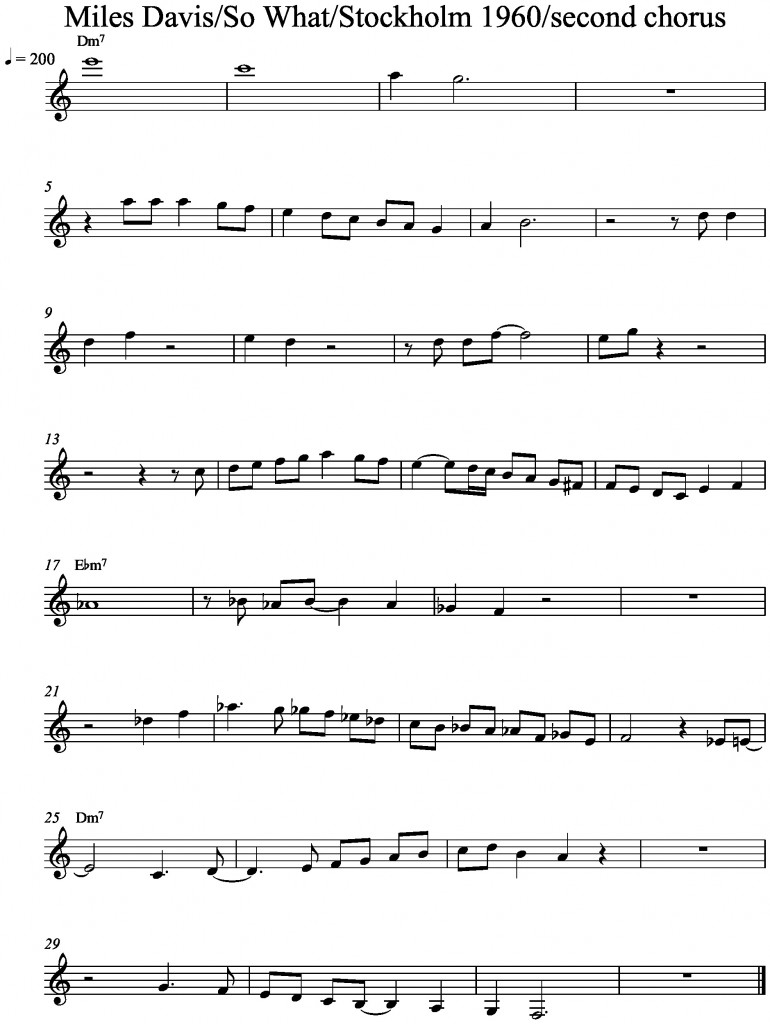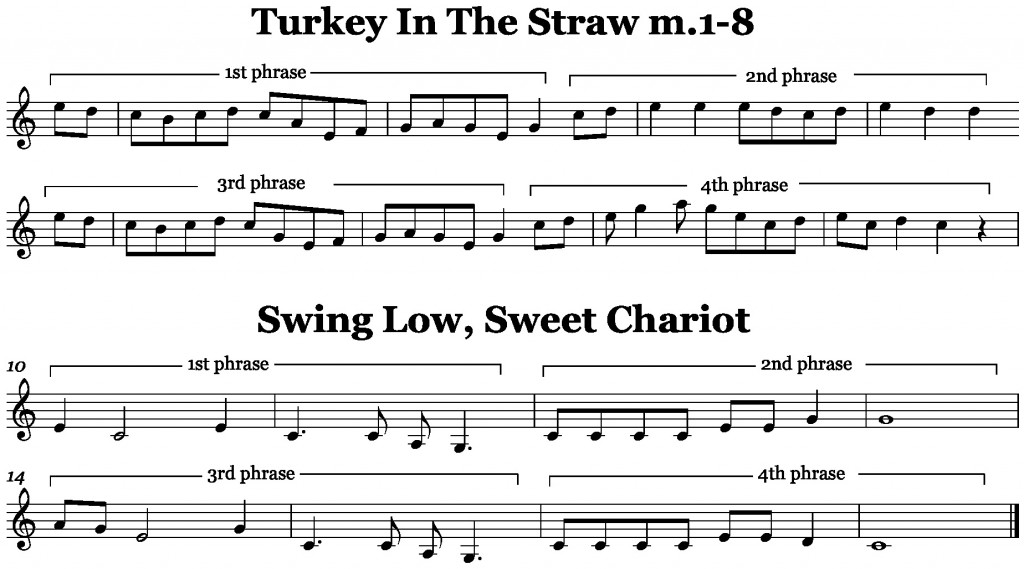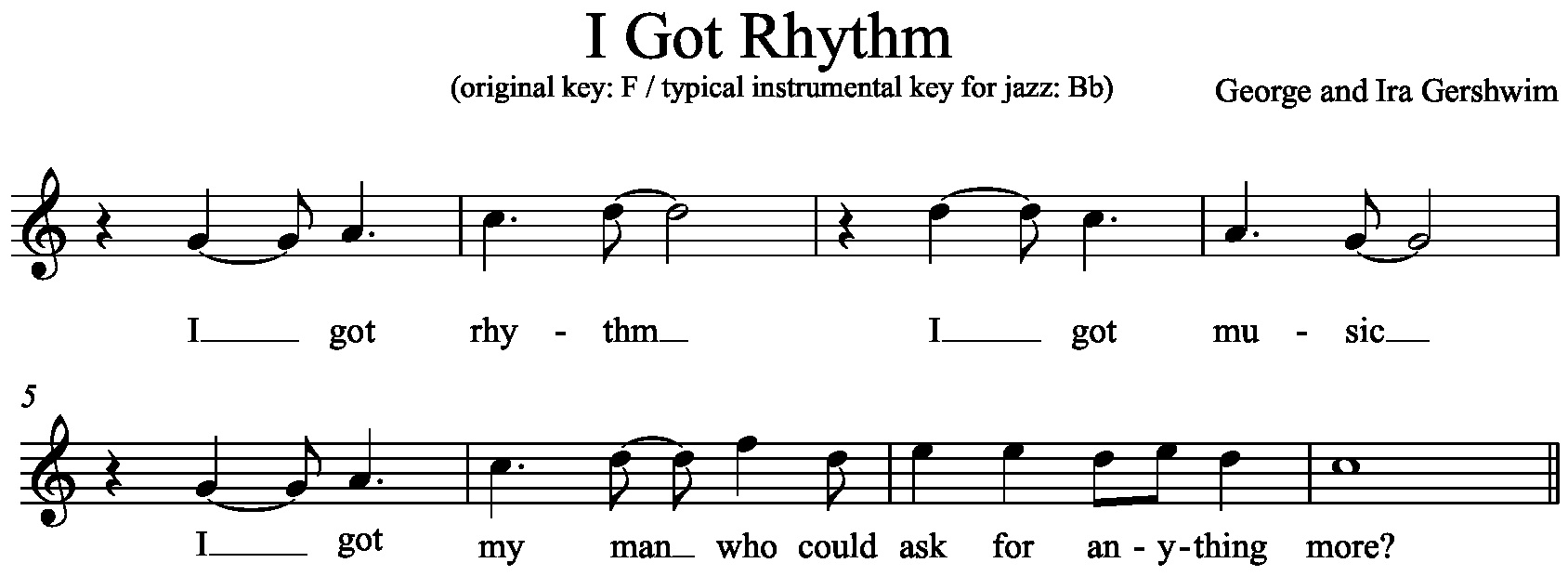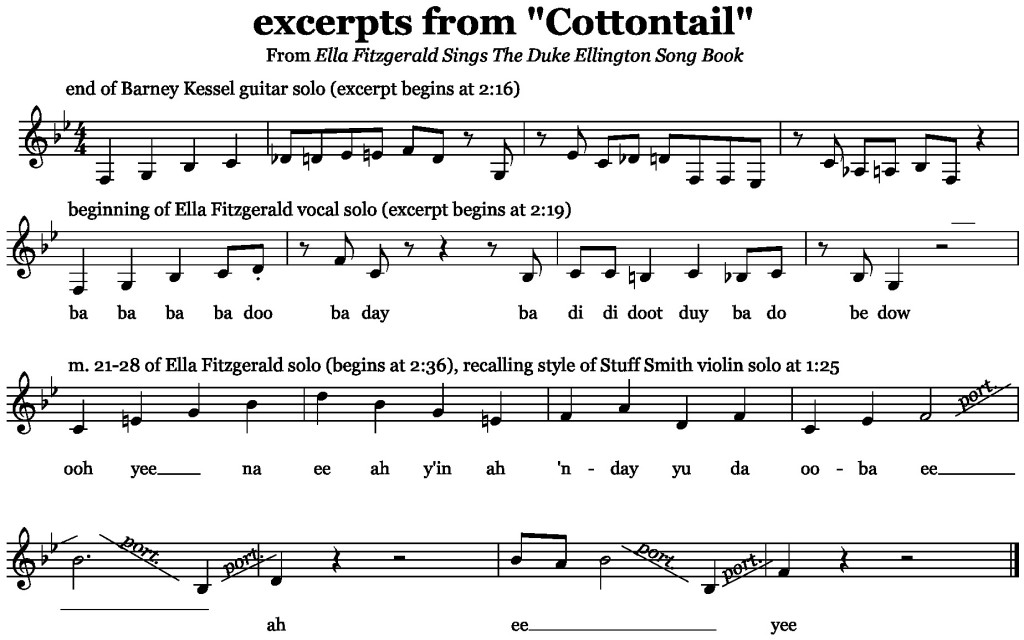When the University of Vermont announced that Wynton Marsalis would give the commencement speech at its 2013 graduation proceedings, it added serious star power to the event, given his well-established career as a cultural spokesman. Marsalis also had a personal reason to be there, as his son Simeon was part of the graduating class. His speech was a moving reflection from a parental viewpoint on the transition to postgraduate adulthood, and the UVM audience responded to it with jubilant and respectful applause. The jubilation was turned up a notch, however, when he put down his speech notes and picked up his trumpet. The tune he chose to play at this moment, ‘When The Saints Go Marching In‘, had a strong association in my mind with the traditional New Orleans funeral parade, as I’d heard that tradition carried on locally by the Onion River Jazz Band at the funeral of a friend. (2016 update: I had the pleasure of subbing for ORJB’s piano player, Andy Ellenberger, on New Year’s Eve last year.) While this tune has been used in many contexts, I had never heard it played at a graduation ceremony, where the stuffy 19th century strains of Elgar’s ‘Pomp and Circumstance’ are usually the main soundtrack. (The UVM Brass Ensemble gave a fine performance of this chestnut at the 2013 ceremony.)
In his speech, Marsalis expanded my understanding of ‘When The Saints’ by explaining how the tune could shed new light on the meaning of a college graduation. “A favorite tradition in New Orleans,” he said, “is the jazz parade. The dancers that follow the band are called second liners. Our most celebrated song, When the Saints Go Marching In, has a line, ‘Lord I want to be in that number, when the saints go marching in’. Well, we are in that number today. We are YOUR second line–your support system. Our presence today IS our pride. And though there is much of life that you must face alone, you cannot make it out here in this world by yourself.”
Marsalis’ ability to transform the meaning of this tune through his speech and his playing (which I discuss below) reminded me of another masterful reinterpretation given to another well-worn sixteen-bar melody in a different genre: Paul Simon’s use of the hymn ‘O Sacred Head, Now Wounded’ in his Watergate-era song ‘American Tune’. The narrator in the text of the hymn, well known for its use in J.S. Bach’s St. Matthew Passion, speaks of identifying his own struggle for salvation with the biblical story of Jesus’ suffering; in some Christian traditions it is sung just before the story of his resurrection is celebrated at Easter. Simon uses the hymn’s melody as the basis of a song which had particular significance in the era following the Vietnam War and the Watergate scandal. Simon’s narrator speaks having been ‘forsaken’ and ‘misused’, but moves from this awareness of personal loss toward a sense of empathy with others in a similar situation, saying ‘I don’t know a dream that’s not been shattered / don’t have a friend that feels at ease’.
Marsalis made a shift in meaning similar to the one Simon made in ‘American Tune’ by taking ‘When The Saints’, a song with lyrics based on the book of Revelations and its images of the end of the world and which which has often been used to commemorate the end of an earthly life, and turning it into a statement of profound hope for a group of young people embarking on their careers. In doing so, he demonstrated, like Simon (who performed ‘American Tune’ at a concert celebrating Jimmy Carter’s inauguration), a crucial service to the public sphere that a master musician can provide: the ability to take a song which seems to have been given every interpretation possible and find yet another level on which it can resonate.
Marsalis’ solo in his UVM version of ‘When The Saints’, accompanied by Ricky Gordon on percussion and framed by head statements with Ray Vega on a second trumpet part, could be described as a short history of jazz improvisation. He begins (at m. 17) in the style of early jazz (staying close to the scale the song is built on – F major – and the triadic harmony of its opening measures), moves into a more blues-based approach (introducing a flatted seventh [E flat], outlining the F 7th chord, introducing what could be called the ‘F minor blues scale’, and including one of the quasi-vocal gestures that Marsalis is so adept at coaxing out of the trumpet) and closes with what I’d call a nod to the bebop language (by using what Barry Harris calls ‘the half step between the fifth and the sixth’).
Marsalis had a number of options available to him for performing the tune – he certainly is a master of the unaccompanied trumpet solo, and his father Ellis Marsalis, a magisterial eminence of jazz piano, was in attendance – but his decision to frame his melodic interpretation with the basic musical elements of rhythm (via Ricky Gordon’s funky bass drum and cymbal) and harmony (via Ray Vega’s counterline) located his version firmly in a call-and-response style. (As we’ll see shortly, the call-and-response style can be contrasted with an approach where the main contrast is between a single solo voice in the foreground and an accompaniment in the background.)
Ray Vega’s answers to Marsalis’ melody phrases during the head in and out provide a real counterpoint to the melody; he finds a number of different ways to counter the ascending motion of the opening phrases with downward motion, and then switches to filling in the harmony in the later phrases of the tune. When Marsalis repeats the melody after his solo, Vega’s responses become more frequent and spirited, which is perhaps what causes Marsalis to alter the melody at m. 41; before that point his repeat of the melody is quite similar to his opening statement. To me, it is another mark of the master musician that Marsalis responds to Vega by finding a way to play one less note in this phrase than he did previously. To my ear this demonstrates how, especially on a small scale, leaving space can be an answer as meaningful (and as respectful) as an audible response.
The power of Marsalis/Vega performance sent me on a voyage of rediscovering this tune that I have taught many times through the arrangement that appears in the Alfred Adult Basic Piano Method Volume One. First, I went to YouTube and checked out a variety of versions of the tune. Some were truly swinging, including the 1938 big band version by Louis Armstrong that began the popular fascination with the song, a 1963 version by one of Armstrong’s small groups that shows his remarkable ability to adapt to changing styles of jazz and multiple generations of players, a live version by the Preservation Hall Jazz Band, and a cool reharmonization by Dr. John. Some were surreal, like the 1960s version led by Dinah Shore on her TV show, featuring Al Hirt, Andy Williams, Ella Fitzgerald, and Perez Prado and his orchestra. All these versions use a call and response structure in some way or other. In doing so, they provide a link to African-American gospel music, the crucible that, through its heat and ingenuity, transformed ‘When The Saints’ and many other folk songs into sources of glorified light in American popular culture.
Listening to these versions helped me understand what is so special about the Marsalis/Vega version: it makes it easy to hear the musical conversation, the calls and responses, through which improvisors collaboratively transform a melody: the lead part creating its variations on the original melody while being influenced by the echoes or counterlines which the second part plays in the breaks. Both the ’63 Armstrong version and the Preservation Hall version follow a typical New Orleans front line approach in which the trombone and clarinet improvise simultaneously in response to the calls of the trumpet as it plays the melody. The result is a joyously busy contrapuntal texture, but if one can isolate the interplay of Armstrong and trombonist Trummy Young in the ’63 video, one can hear the conversational tradition that Marsalis and Vega draw from in their duet. In this tradition, all voices are free to participate in the statement of a theme by adding their own variations and even to occasionally overlap the lead voice. In the Marsalis/Vega duet, however, Ray Vega skillfully demonstrates an important guideline for the melodic conversation: in order to overlap meaningfully with one’s duet partner, one must first know how to stay out of their way.
The vocal sections of all the versions, with their simpler calls and responses, can seem almost dull by comparison; however, they also function as a tension-releasing break before individual solos (although the soprano descants added by Jewel Brown in the ’63 Armstrong version and Ella Fitzgerald in the Dinah Shore version certainly keep the energy from flagging.) The more arranged call-and-response heard in the openings of the ’38 Armstrong version and the Dinah Shore version are lower in energy and place more responsibility on soloists to lift the energy of the performance. As the Dinah Shore version shows, performers who are less conversant with improvising tend to limit themselves to minimal variations on the melody, and not even the presence of a great improviser like Ella Fitzgerald, or a great band like Perez Prado’s, can stop the tendency of this kind of performance to flatten out dynamically. (Trumpeter Al Hirt is the only white performer in this situation who can offer anything other than slight variations on the melody.)
Other versions of ‘When The Saints’ are forgettable and yet indicate the wide ranging impact of the tune, like the version by the Beatles in an early incarnation when their lead singer was Tony Sheridan, whose voice showed a heavy Elvis Presley influence. Although this version neuters the song by removing swing feel and call-and-response structure, it demonstrates the Beatles’ gift for mimicry, as it seems they and Sheridan imagined what a version by Elvis would sound like before Elvis himself had recorded the tune. (YouTube suggests that Elvis didn’t record the tune until a 1965 version in the film Frankie and Johnny, a few years after the Beatles became a success in the U.S.A. Although Elvis’ version has more swing feel than the Beatles’ version, it neuters the song in other ways, combining it in a medley with ‘Down By The Riverside’ sung by an all-white chorus and marching band.) The Beatles’ version also provides a link to a later and more evolved phase of their creativity: in their original tune ‘I Saw Her Standing There’, they borrow the chord progression from ‘When The Saints‘ but disguise the borrowed material through adding new harmonic twists and a bridge of unusual length for a pop song.
I also looked up ‘Streets Of The City’, a tune by New Orleans composer Paul Barbarin which uses the same chord changes as ‘When The Saints‘. (While Barbarin’s tune is a jazz variation on the tune, the same changes are shared by tunes in other tradtions, including ‘She’ll Be Comin’ Around The Mountain’, Willie Dixon’s ‘My Babe’ and its gospel forebear, Sister Rosetta Tharpe’s ‘This Train’.) A version of ‘Streets‘ by clarinetist George Lewis (available on iTunes) includes a great solo by pianist Alton Purnell which demonstrates how the call-and-response concept can be applied on the piano. Purnell’s left hand spends most of the chorus doubling the bassline in the low register of the piano, but in the middle of the chorus Purnell includes some more block-chord style comping through which his left hand responds to his right much as Vega responds to Marsalis in m. 10-17 of ‘When The Saints’. 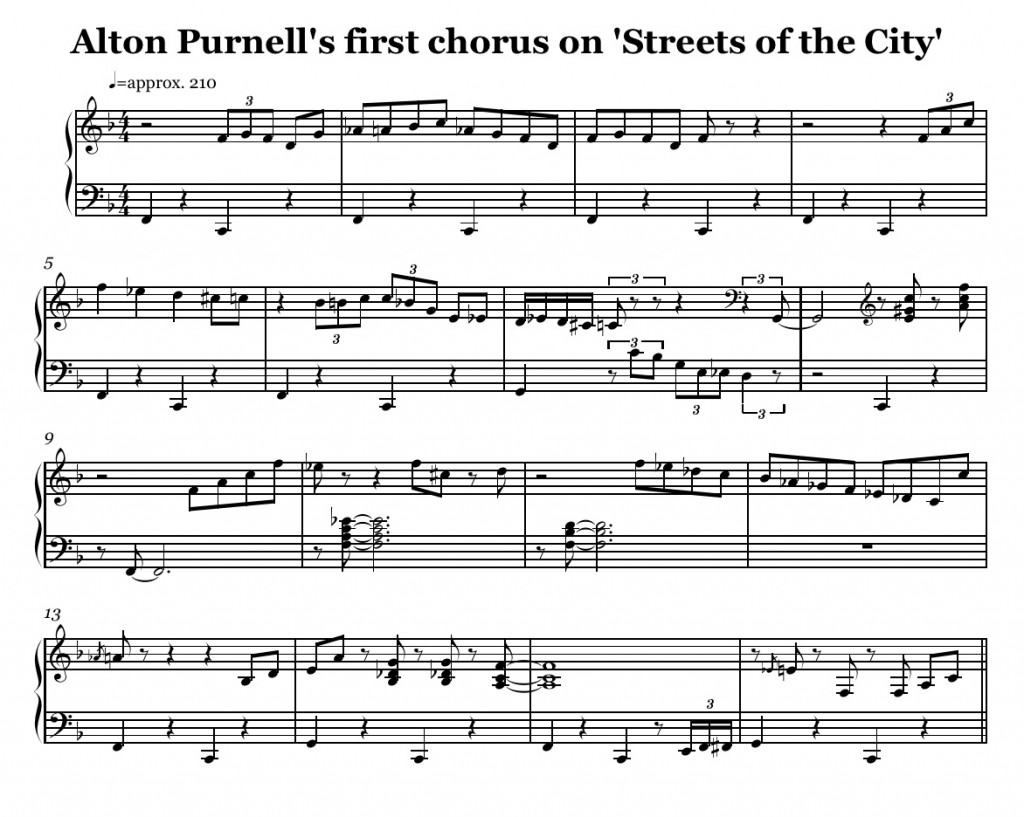
The first chorus of George Lewis’ clarinet solo, like Marsalis’ solo at UVM, is a model of how to combine diatonic playing (which in the case of this tune means limiting oneself to the F major scale) with judicious chromaticism that helps the improvised line ‘make the changes’.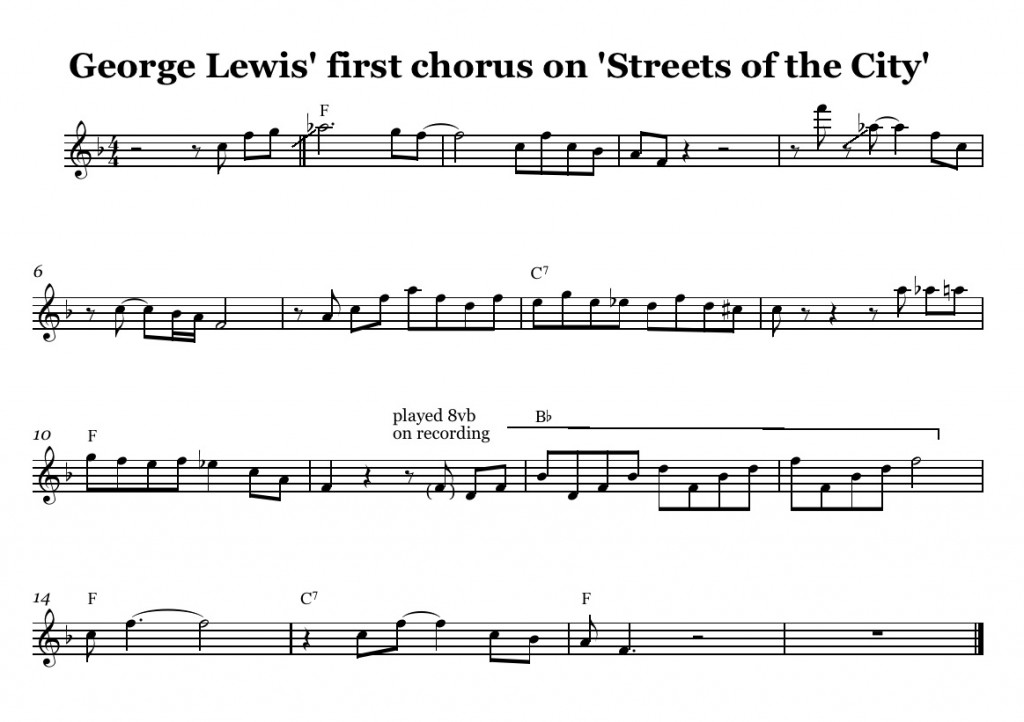
On a visit to the Montreal Jazz Festival about a month after Marsalis‘ speech, I heard Charles Lloyd and Bill Frisell play an inventive version of the folk tune ‘Red River Valley’. In addition to demonstrating the gift that both these players have for using any tune as an improvisational vehicle, it reminded me that this tune uses the same changes as ‘When The Saints’ with the addition of a IV chord in the third bar. A little more rummaging through my musical memory made me realize that Bob Dylan uses the ‘Red River Valley’ changes, with the addition of a bridge, in ‘You’re Gonna Make Me Lonesome When You Go’. The lyrics of Dylan’s tune use the phrase ‘Careless Love’, which is also the title of a tune with a progression that, like ‘Red River Valley’, works a slight variation on the progression of ‘When The Saints’. (I remember feeling homesick in Italy and hearing a version of ‘Careless Love’ by Dr. Michael White and his band that melted my melancholy away.)
The progression from ‘When The Saints‘ is also a musical ancestor of the progressions found in Horace Silver’s ‘The Preacher’, Jerome Richardson’s ‘Groove Merchant‘ and Sonny Rollins‘ ‘Doxy’. (Dig the opening solo by a young Roland Hanna in the ‘Groove Merchant’ video!) In the version of ‘Doxy‘ from ‘Miles Davis and The Modern Jazz Giants’ (available on iTunes), Horace Silver’s piano solo demonstrates how pianists from the bebop era onward moved the role of the left hand away from the metronomic timekeeping heard in most of Purnell’s solo and made it an independent voice which could use chords as conversational responses to right hand melodic phrases. Where call and response is a primarily a method of melodic evolution in the Armstrong and Marsalis versions, Silver’s solo is like a tennis game between harmony and improvised melody in which the left hand lends a sense of tension to the chord progression by bringing many changes in a half beat earlier (and in m. 6, a beat and a half earlier) than they appear in the bass line.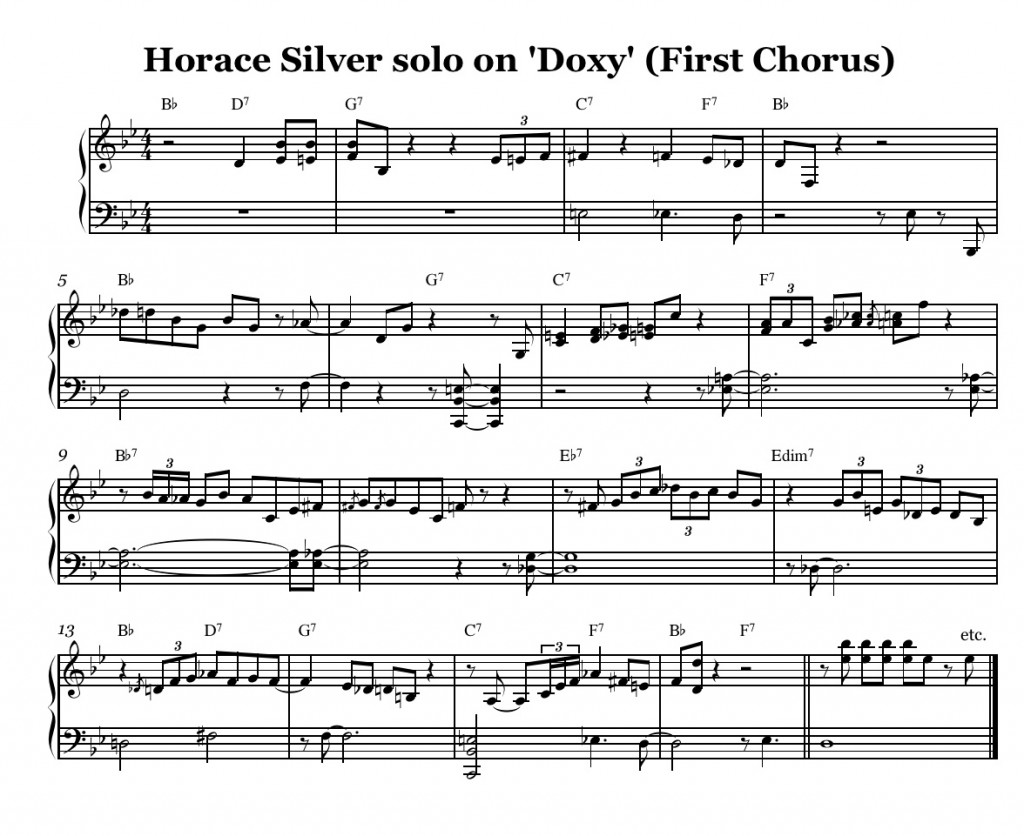
Saxophonist David Murray and drummer Steve McCall make great use of ‘Doxy’ in their accompaniment to the Amiri Baraka poem ‘The Last Revolutionary’ on the early eighties record ‘New Music, New Poetry’. (Baraka’s poem, which skewers leftist icons like Abbie Hoffman and David Dellinger, offers a counterpoint to conventional narratives of 1960s political activism, and is a prime example of Baraka’s poetic gifts.) The sarcasm with which Murray plays the tune in this version helped me connect it with a number of tunes that use very similar progressions and fall into a category that might be called the ‘gospel of the marketplace blues’. This was a prolific trend in pop songwriting of the 1920s and 30s: tunes that used the premise of either advertising a product or offering cautionary advice to the buyer. These include advertising tunes like Robert Johnson’s ‘They’re Red Hot‘ and its distant cousin, Arlo Guthrie’s ‘Alice Restaurant’ and cautionary tunes like Sippie Wallace’s ‘Women Be Wise’ and Fats Waller and Andy Razaf’s ‘Find Out What They Like And How They Like It’.
‘Find Out What They Like’, which Waller seems not to have recorded himself but rather intended as a vehicle for female singers, has had its shelf life extended by being included in the late 1970s Waller/Razaf revue ‘Ain’t Misbehavin’. One of the earliest versions of it, by vocalist Lena Wilson (available on iTunes), shows its potential as a jazz standard through an exemplary solo by the unsung stride pianist Cliff Jackson. Jackson’s solo reminded me of the many great uses that were made of this progression by players and composers in the stride piano style, from James P. Johnson’s ‘Feelin’ Blue’ to Art Tatum’s version of ‘Ja-Da’. (To give credit where credit is due, I wouldn’t have discovered ‘Feelin’ Blue’ without Ethan Iverson’s exhaustive and fascinating blog entry on James P, and I was introduced to Tatum’s ‘Ja-Da’ by hearing Michael Arnowitt give a masterful performance of the transcription.)
Although the world-weary humor of Sippie Wallace and Fats Waller seems far removed from the reverence and sincerity of Paul Simon in ‘American Tune’ and Wynton Marsalis in his UVM rendition of ‘When The Saints’, all these tunes and performances demonstrate an important jazz truth: knowing and respecting a tune, and having some awareness of its origins, gives you the flexibility to interpret it in a way that tells a new story. To put it in different terms, if you know where the train you’re riding began and where it’s headed, you can relax and tell your story along the way.
